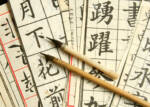着 zhe in Chinese: The Aspect Particle

It’s HAPPENING NOW, how can you use a helper particle (助词) to express that something is currently taking place? Use 着 (zhe in Chinese)!
Reminder About “Helpers”
The term “Helper” derives from the Chinese word for ‘particle’ 助词 zhù cí – ‘help + word.’ These ‘helpers’ are rarely grammatically required, but they ‘help’ the sentence by clarifying things like possession (的), change (了), or present actions (着).
Before we get too far into the weeds with this particle, we’d like to point out that 着 (zhe in Chinese) is not the only way to express that an action is currently happening. You can also place 正 (zhèng), 在 (zài) or 正在 (zhèngzài) before the action, or put 呢 (ne) at the end of the sentence. However, for this post, we’ll keep the focus on 着 (zhe in Chinese).
Sentence 1 – 着 (zhe in Chinese):
台上坐着几个人。 – Level 14
Táishàng zuòzhe jǐge rén.
A few people are sitting on the stage.
One way to translate 着 (zhe in Chinese) is the suffix ‘-ing.’
坐 – sit, 坐着 – sitting.
站 zhàn – to stand, 站着 – standing
跑 pǎo – to run, 跑着 – running
Sentence 2:
他坐着吃饭。 – Level 16
Tā zuòzhe chīfàn.
He’s sitting and eating.
This sentence has two actions, sit 坐 (zuò) and eat 吃 (chī). When you have two actions, it’s unnecessary to add “着” (zhe in Chinese) behind both. We can assume that if the speaker adds 着 after the first action of sitting, that the second act of eating is also taking place in the present.
Sentence 3 – 着 (zhe in Chinese):
你自己看着办吧! – Level 16
Nǐ zìjǐ kànzhe bàn ba.
You can do as you see fit.
This is a highly useful sentence in everyday life. Any time that you want to leave someone to their own devices, you can use this sentence. Just like 坐着吃饭, there are two actions here 看着办.
看着 – seeing
办 – deal with
The speaker is effectively saying that you can have the “dealing with” be the direct result of the “seeing,” which is a rather eloquent way of telling someone “do as you see fit.”
Sentence 4:
那张床上铺着被子。 – Level 20
Nà zhāng chuángshàng pūzhe bèizi.
That bed has a quilt spread over it.
It’s easy to think of 着 (zhe in Chinese) as applying to fleeting moments. For example, if two people are talking right now, it will quickly pass into the next moment where they aren’t.
However, 着 (zhe in Chinese) sometimes applies to things like a quilt spread over a bed, or a TV hanging (挂着) on a wall (墙上挂着电视机 qiángshàng guàzhe diànshìjī). This goes to show that you can also use 着 to describe primarily static things.
Stay in the PRESENT
Keep looking out for the particle 着 (zhe in Chinese) as you move forward, and each time you see it, imagine that the action is happening right now. Remember, visualization occurs naturally as a result of reading sentences, dig into it!








